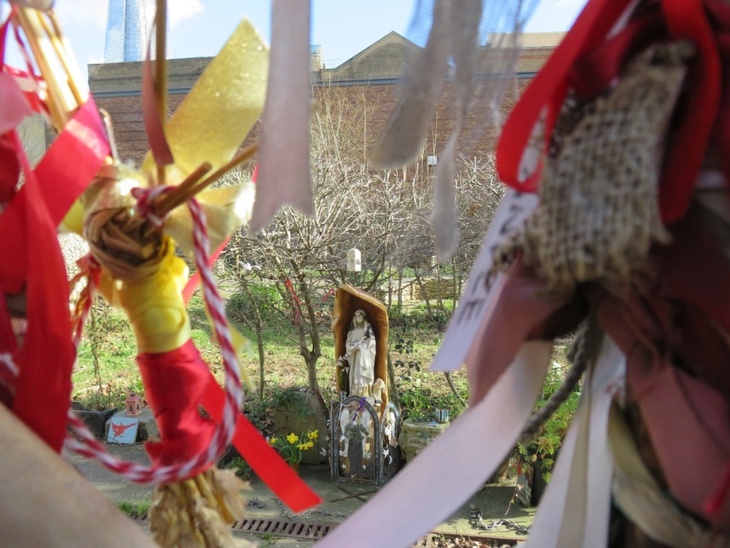Pssst. Want to know a buried secret? We've had a dig around to find the capital's strangest burial sites.
1. An explorer and his cat, Platform 15, Euston

Next time you're rushing for the 18.33 to Watford Junction, do spare a thought for celebrated navigator and cartographer Captain Matthew Flinders, who is reportedly buried beneath Euston's Platform 15. Well, where else would you expect to find the first man to circumnavigate Australia?
A very fine statue of Flinders and his cat Trim now stands just outside the station, having been moved from the indoor concourse (where it was often covered in commuters and empty Starbucks cups — nice).
2. The bricklayer with a stake through his heart, Centre Point, Tottenham Court Road

While you try to negotiate the Crossrail building works at this busy crossroads, do spare a thought for bricklayer John Duke, who's buried with a stake through his heart somewhere beneath the skyscraper. Don't feel too sorry for him though: Duke took his own life after murdering his wife in 1761. If anyone brags to you about scoring a luxury apartment at Centre Point, be sure to tell them this tale.
3. Giro the 'Nazi' dog, Carlton House Terrace

In a shady corner, just off Pall Mall, stands the grave of 'Giro the Nazi dog', beloved pet terrier of 1930s German ambassador Leopold von Hoesch. To be fair, it's more than a little uncharitable to call Giro a Nazi — what with him being a dog, after all — but it's a name that's stuck.
The poor pooch met an untimely end when he chewed through an electric cable in the garden of the German Embassy, which was then at 9 Carlton House Terrace.
4. The 'Dulwich Hermit', The Old Burial Ground, Dulwich Village

You may be surprised to learn that this well-tended but very compact patch provides the final resting place for more than 3,000 locals, who died between 1616 and 1857. Among those who reside in unmarked graves are: 'Old Bridgett, the Queen of the Gypsies', who died in 1768; Samuel Matthews, the 'Dulwich Hermit', who was was murdered in his cave in Dulwich Woods in 1803; and 35 victims of the Great Plague of 1665.
5. The good, the bad and the ugly, Altab Ali Park, Whitechapel

The few tombs dotted around this East End park are all that remain of the 14th century St Mary Matfelon church, which was demolished following a lightning strike in the 1950s. Philanthropist Sir John Cass (the good), 18th century naval mutineer Richard Parker (the bad), and Charles I's rumoured executioner Richard Brandon (the ugly) are all buried here. Come one, come all.
6. A PM's dad, and a top boxer, Novo Cemetery, Mile End

Established in 1733, this Jewish cemetery seems somewhat incongruous with its present-day surroundings: the centre of the Queen Mary, University of London campus. After the university purchased the land in 1972, 7,000 bodies were exhumed and reburied in Essex. The remainder of the cemetery was renovated in 2012, in consultation with the Spanish and Portuguese Jews' Congregation. Notable burials here include Benjamin D'Israeli (grandfather of the Victorian prime minister) and prizefighter Daniel Mendoza.
7. Medieval prostitutes, Crossbones Graveyard, Southwark

This pretty patch near London Bridge was once the graveyard for The Mint, one of London's poorest and most violent slums. Around 15,000 people — half of them children — are buried here. It's rumoured to be the final resting place of the Winchester Geese — medieval prostitutes, licensed by the Bishop of Winchester to work in the nearby brothels.
Thanks to volunteers it's normally open on weekday lunchtimes — but the colourful shrine on the outer railings is worth a visit any time. Or visit for one of the candlelit vigils.
8. Oliver Cromwell's decapitated body(?), Red Lion Square, Holborn

Take a break in this tranquil spot and you may be surprised to learn you're just a few feet away from the remains of (most of) Oliver Cromwell. Well... possibly. The one-time Lord Protector was originally buried in Westminster Abbey in 1658. But after the Restoration in 1660, Parliament decreed that his body — along with those of two more renegades, Bradshaw and Ireton — should be posthumously tried and hanged at Tyburn. However, rumour has it the trio's decapitated bodies were swapped overnight and buried in a pit on the site of the Square.
9. A young roman girl, 30 St Mary Axe (The Gherkin)

Back in 1995, archaeologists working on the building site at 30 St Mary Axe — aka the 'Gherkin' — uncovered the 1,600-year-old remains of a young Roman girl. While construction continued, the girl was rehoused at the Museum of London until April 2007, when she was returned to her original resting place following a church service and funeral procession. Her grave is now marked with a memorial on one of the marble benches.
10. The cook who served arsenic dumplings, St George's Gardens, Bloomsbury

These beautifully renovated gardens once served as the burial ground for two nearby churches, and remain consecrated ground. Among the notables buried here are a group of Jacobite rebels, who were hanged, drawn and quartered on Kennington Common; statistician and anti-slavery activist Zachary Macaulay; and Eliza Fenning, a cook who was hanged for attempted murder in 1815 after serving arsenic-laced yeast dumplings.
11. The tree surrounded by dozens of graves, Old St Pancras Churchyard

Obviously, you won't be too surprised to find gravestones in the grounds of a church. You may, however, wonder why so many of them have been packed together beside an ash tree. This innovation is reported to be the work of author and poet Thomas Hardy, who, during an early stint as a trainee architect, was tasked with relocating many of the graves to make way for the new railway lines in the mid-19th century.
It's one of the very few burial sites we can think of that's famous for who arranged it, rather than who's in it.



